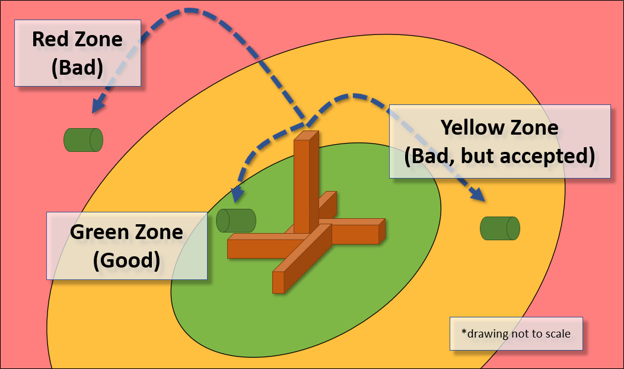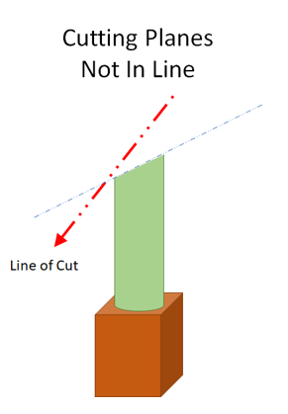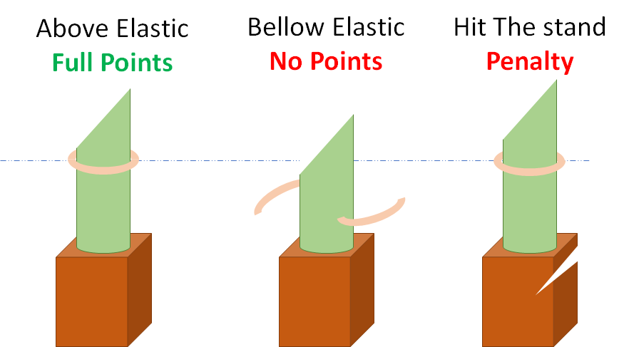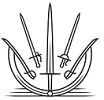Tournament participants must follow the directions of the tournament director and staff at all times. Any participant exhibiting behavior that places themselves or others at risk of harm will result in immediate disqualification and possible intervention by local law enforcement.
- Tournament Goals
- Safety Regulations
- Tier-B Cutting Patterns
- Tier-A Cutting Patterns
- Quality Standards
- Competitor Conduct
- Equipment
Tournament Goals
The goal of the SoCal Swordfight cutting tournaments is to:
- Showcase/evaluate/reward sword skills that can not be tested in a sparring environment.
- Promote an integrated training regiment, with good cutting mechanics in sparring and good fencing behavior in cutting
- Be creative, educational, and enjoyable for both participants and spectators.
Safety Regulations
All competitors will be required to assume proper safe-handling procedures for sharp swords. This includes, but is not limited to:
- Not extend the off-hand forward away from the body while cutting. (Keep it next to or behind the torso.)
- Follow the instructions of the tournament staff without hesitation or argument, including approaching the target from the specified direction.
- Maintain an awareness of surroundings at all times, and not under any circumstances swing the sword in the vicinity of others.
- Ensure hands and hilt are dry before wielding a sword. Competitors are not to handle mats at any time during the tournament without explicit instruction from staff.
- Do not cut before the tournament staff indicate that they are ready for you to begin.
- Be aware of the sharp swords potential for injury if used without the proper respect and safety protocols.
Should the tournament officials perceive that there is any safety issue, they retain the right to remove individuals from the cutting tournament at their discretion.
Tier-B Cutting Patterns
Round 1 - Descending Cuts
Target 1 - Single Tatami Roll
Competitors will perform 3 descending cuts on each side, in any order. (6 total cuts)
Target 2 - Hanging Paper
Competitors must perform 6 descending cuts, 3 on each side.
Top 9 by score will advance to the next round.
Round 2 - More Cuts
Target 1 - Single Tatami Roll
Competitors will perform 3 ascending cuts on each side, in any order. (6 total cuts)
Target 2 - Hanging Paper
Competitors must perform 4 descending cuts, on the same side, in a continuous motion. This will be repeated on both sides.
The recovery between swings need not be fast, but should show no signs of hesitation.
Top 4 by cumulative score advance to the Final Round.
Round 3 - Reactive Cutting
Target 1 & Target 2 - Single Tatami Roll
Competitors will perform cuts as prompted by the tournament staff. (Single tatami mat).
Eligible cuts:
- Descending Right
- Descending Left
- Ascending Right
- Ascending Left
Tier-A Cutting Patterns
Round 1 - Reactive Cutting
Target 1 & Target 2 - Single Tatami Roll
Competitors will perform cuts as prompted by the tournament staff.
Eligible cuts:
- Descending Right
- Descending Left
- Ascending Right
- Ascending Left
Top 7 by score will advance to the next round.
Round 2 - Controlled Cutting
Target 1 - Close Cuts
Competitors will start with the lead foot touching the cutting stand. They must step backwards and execute a cut towards their lead leg.
Example ↓

Target 2 - Draw To The Button
Competitors will be presented a sheet of hanging paper with 6 dots marked on it. They will perform each of the 6 basic cuts with the aim of bringing the sword to rest as close to the target dot as possible.
Example ↓

Top 4 by cumulative score advance to the Final Round.
Round 3 - Cutting Feats
Feats to be announced after the completion of Round 2.
Quality Standards
In each round of the cutting tournaments each cut (single cut or multiple cut task as explained in each round) is worth a total of 20 possible points - 10 points from each judge. For each cut a competitor starts at the max point value with deductions applied for errors in form and the result of the cut (as detailed below).
Each judge will be tasked with scoring a certain portion of the cut (person or mat) and take note of deductions observed. After a cut each judge will record the highest deduction observed for that cut. i.e. the mat judge observes 2 errors in a cut, a scallop which is -2 and a successful cut where the sword strikes the stand which is -5, only the -5 is applied to the cut score. Points are only awarded for successful cuts and there are no points for partially completing the task with a failed cut.
Tatami Deductions
Cut Form
'x' indicates that no points will be awarded.
- [-3]: Stepping ahead of cut Example ↓
If the lead foot is firmly plated while the sword is being chambered/accelerated.
- [-5]: Expose Back Example ↓
The exposes the full side/back while completing the cut.
- [-5]: Entering Waiting Area as Signal Period Ends* Example ↓
Reactive cutting round only.
- [X]: Not In Waiting Area When Signal Period Ends* Example ↓
Reactive cutting round only.
- [X]: Leaving Waiting Area Ahead of Signal* Example ↓
Reactive cutting round only.
Cut Quality
'x' indicates that no points will be awarded.
- [-5]: Small Mountain Example ↓
A mountain is when a cut intersects a previous cut or cut attempt. This is penalized because the competitor no longer needs to cut through the full width of the target, and also because it demonstrates poor targeting and control. Small mountains will be assessed a point deduction of -5 points.

- [-3/-5/-8]: Tatami Landing Distance (yellow) Example ↓
- [X]: Tatami Landing Distance (red) Example ↓
‘Landing Zones’ will be used to assess cutting quality. These zones will be clearly marked on the ground around each cutting stand.

- The zone deduction is assessed based on the position at which the tatami first comes into contact with the ground (i.e. rolling after contact does not impact the score).
- In the event that a clearly defined piece cannot be identified, the cut will be assumed to have landed in the red zone.
- Should a cut spray debris, it will be assumed to have landed in the red zone.
- Should a piece land straddling two zones, it will be assessed as landing in the lower deduction zone.
- [X] Scallop Example ↓
A scallop is defined as a cut which clearly curves its trajectory in the tatami mat. This also applies to any parallel mat cuts which do not have the two cuts in the same line.

- [X] Large Mountain Example ↓
A mountain is when a cut intersects a previous cut or cut attempt. This is penalized because the competitor no longer needs to cut through the full width of the target, and also because it demonstrates poor targeting and control. Cuts with mountains of greater than 1” (25.4 mm) will be awarded no points.

- [X] Tatami Surface Not In Line With Cutting Plane Example ↓
This is a phenomenon that can occur with extremely sharp swords which are highly optimized for cutting. If the tatami ends up cut on a different plane than the one on which the sword was swung, it indicates that the competitor performed a ‘failed’ cut, but that their sword was able to overcome this and still pass through the thin tatami targets.

- [X] Cut Below Limit Example ↓
The lowest rubber band on the tatami mat will indicate the lowest height a competitor may cut at. Any cuts that pass below this line will receive no points. Should the competitor hit the stand or floor, they will receive no points for the cut and instead have a value of -10 applied to their overall score.

- [X] Failed Cut
- [X] Wrong Cut
Competitor Conduct
Competitors shall not begin cutting until instructed to do so by the tournament staff. Following the completion of each cut, the competitor must wait for confirmation from the cutting judges before beginning their next cut. After assessing the quality of a cut, the cutting judges will hold up a color-coded card to provide feedback to the cutter and the audience and to indicate that the competitor may make their next cut. A competitor may not address the table to inquire about a score which has been awarded. These cards will be:
- Green - No point deduction on cut
- Yellow - Point deduction on cut
- Red - No points awarded on cut
- Verbal Warning - Penalty assessed
Should a competitor request a mat straightening (provided the round allows for it), they must first step out of the cutting area with the tip of their sword pointed toward the ground. The competitor must not move until instructed to do so by the tournament staff.
Competitors that take excessive time to begin after they have been signaled to cut will be warned by the tournament staff, and may be subject to penalties if there are repeated infractions. While it is not necessary for a competitor to rush after they are prompted, it is intended that they perform the cut in a short period of time without spending considerable time ‘fidgeting’ or ‘psyching themselves up.’
During reactive cutting rounds, the competitor must wait in an area designated by the tournament staff. Only once the cut has been signaled may they move forward and execute their cut. The competitor must then return to the waiting area before the signaling period has concluded or be assessed a point deduction on the cut.
Equipment
There will be a loaner arming sword available.
European arming swords only. No messers, no sabers, etc. If you are using something that isn't sold as an arming sword by a reputable European sword manufacturer you must get approval for the sword.
The tournament is under no obligation to let you use a sword that you've brought.



























